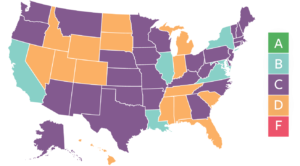In honor of Rheumatic Disease Awareness Month, the ACR released a new Rheumatic Disease Report Card as part of its Simple Tasks public awareness campaign. The report card seeks to help answer the question, “How easy is it to live with rheumatic disease in my state?”
First released in 2018, the report card has been updated to provide new scores to see how much states have improved. It considers such factors as access to care, affordability, and activity and lifestyle elements when providing each state with a score and corresponding letter grade.
 The access category considers number of residents per rheumatologist, the percentage of residents who lack insurance coverage, the strength of the state’s laws to limit prior authorization and the strength of the state’s legislation to limit insurers’ use of step therapy.
The access category considers number of residents per rheumatologist, the percentage of residents who lack insurance coverage, the strength of the state’s laws to limit prior authorization and the strength of the state’s legislation to limit insurers’ use of step therapy.
The affordability category awards states points on the basis of the presence of state legislation limiting insurer use of specialty tiers, the strength of the state’s laws promoting pharmacy benefit manager (PBM) transparency and the presence of state legislation preventing insurers from implementing copay accumulators.
The activity category looks at such factors as the prevalence of arthritis-attributable activity limitation among adults, the percentage of adults who are physically inactive and the prevalence of Centers for Disease Control and Prevention (CDC) funded arthritis intervention programs.
Each state received a numerical score and a letter grade in each area. The potential total score was 150 points. States then received an overall letter grade to reflect their score.
Which States Made the Grade?
No states received an overall grade of A. However, five states achieved a B, the highest grades awarded:
- New York (a score of 111 out of 150);
- Virginia (106/150);
- Maryland (105/150);
- California (93/150); and
- Illinois (92/150).
Most states received an overall grade of C or D (see map, above).
The state with the highest score in the 2018 report card was Maryland, followed by New York, Vermont, Colorado and Connecticut.
This year’s report card recognizes Oklahoma as the most improved state … . Its score went up by 31 points, & it moved from the lowest scoring state [in 2018] to a ranking of 20th place in 2022.
This year’s top scorer, New York, earned an A for access and was the only state to do so in that category. “The A in the access category was due to the strength of its state legislation to limit insurer use of prior authorization and step therapy, as well as its low ratio of people per rheumatologist,” says Jocelyn Givens, director of public relations and communications at the ACR. New York received a B for affordability and activity.
The states that received the lowest scores were Idaho (42/150), Mississippi (39/150), South Carolina and Nevada (both 38/150) and Wyoming (37/150). All five earned an overall letter grade of D.
South Carolina, Wyoming and Mississippi were among the lowest in the 2018 report card, along with Alabama and Oklahoma.
This year’s report card recognizes Oklahoma as the most improved state, moving to an overall C grade vs. D in 2018. Its score went up by 31 points, and it moved from the lowest scoring state to a ranking of 20th place in 2022. Oklahoma is one of only 13 states that have passed laws to ban state-regulated insurance plans from using copay accumulators. These accumulators are used by insurers and PBMs to prevent drug manufacturer copay assistance coupons from counting toward a patient’s deductible and maximum out-of-pocket spending.
Oklahoma and Louisiana were the only two states to see an increase in their grades.
This year’s lowest ranking state, Wyoming, had an F for both access and affordability, and a C for activity. The state can improve these areas by passing legislation that promotes PBM transparency and preventing insurers from implementing step therapy, prior authorization, copay accumulators and specialty tiers, Ms. Givens says.
Access, Affordability, Activity
Looking further at grades given by category, states are a mixed bag in terms of access. While New York received an A, most other states earned a B, C, or D. South Carolina, Nevada, Utah and Wyoming all earned an F for access.
The report card points out the stark difference in some states regarding the number of rheumatologists working there. In Massachusetts, there is one rheumatologist for every 19,000 people; in Wyoming, it’s one rheumatologist per 156,611 people. The overall average is one rheumatologist per 40,000 people, according to the report. A lack of health insurance also remains a problem for many with rheumatic diseases.
This year’s lowest ranking state, Wyoming, had an F for both access & affordability, & a C for activity.
Under affordability, many states received a D or F—in fact, 20 states received an F. This is often due to “exorbitantly expensive” prescribed treatment costs. Although some states have made changes to reform PBM practices since 2018, fewer than half have put limits on insurers’ use of specialty tiers or prohibited the use of copay accumulator programs that leave patients with higher out-of-pocket costs. Louisiana received the only A for affordability. A handful of other states received a B.
States fared better overall in the activity category, with more receiving an A or B. The one state that received an F was Mississippi.
All states and the District of Columbia now have at least one CDC-funded activity program implemented by the YMCA or another prominent group. Policymakers can help find funding for evidence-based rheumatology intervention programs, such as those funded by the CDC, and support program participation in rural areas and underserved communities, according to the report.
Using the Report Card Results
Policymakers, rheumatology professionals and patients can work together and use the report card findings to address access, affordability and lifestyle factors to improve the lives of those limited by pain and disability, Ms. Givens says. This is important because of the large number of people living with chronic diseases, such as rheumatoid arthritis and lupus, who are finding it harder to afford their prescription medicines and access specialized care, she adds.
The ACR has continued to lobby at both the federal and state level for improvement in the areas of access, affordability and activity, as outlined in the report. Leaders have seen some progress in the past four years.
“The full report card gives all the states scores in individual categories, as well as case studies on key issues impacting the scores and an appendix that provides all the data on how the scores were compiled,” Ms. Givens says. “We hope states will use this information to identify the various opportunities they have to raise their score.”
With the majority of states receiving an overall grade of C, there is still a lot of work to be done to help those living with rheumatic disease, she adds.
Vanessa Caceres is a medical writer in Bradenton, Fla.


